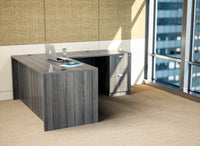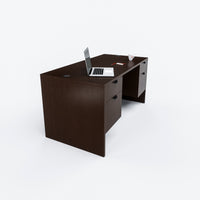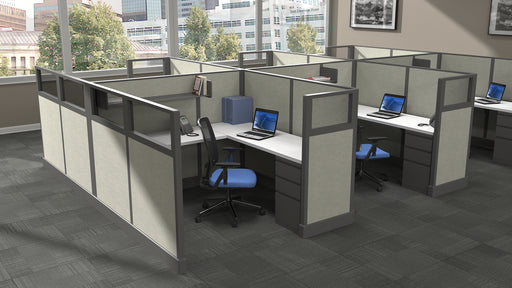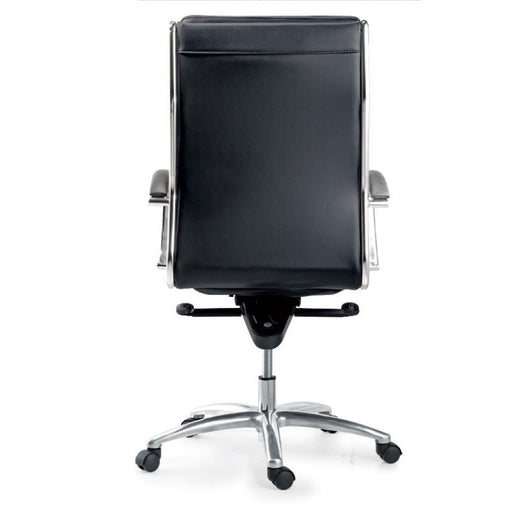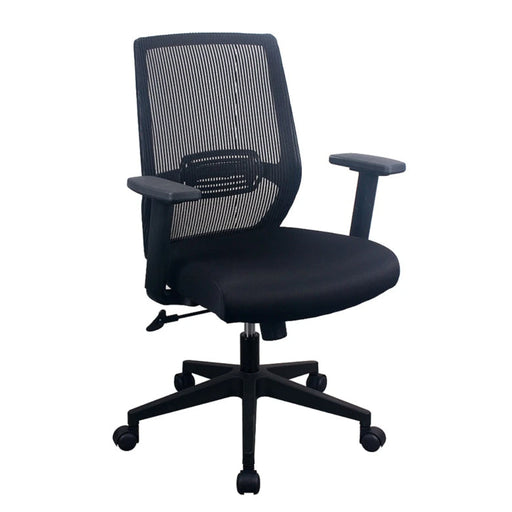-
- Satellite Offices
- Boca Raton
- Miami
- Jacksonville
- Naples
- Sarasota
- Fort Myers
- Gainesville
- Ocala
- Daytona Beach
- Tallahassee
- Hollywood
All Locations -
0

Ergonomic Desk Height: The Complete Guide
There's nothing worse than sitting at your desk for long periods and feeling like you have to lie down and rest your back after four or five hours. Ensuring your desk is at the right height will reduce the potential for back strain and pain—helping you stay productive all day!
Keep reading as we explore everything you need to know about the correct desk height for ergonomics. This guide will give you the knowledge to adjust your desk or chair perfectly.
Are you considering a more ergonomic office design? Check out the ergonomic furniture at Freedman's—productivity starts with comfort!
Proper Desk Height: An Important Aspect of Ergonomics
How do you know that your desk is the right height? Here are some of the key indicators that show your desk is aligned correctly, no matter the type of desk you choose.

Eyes
You should aim to position the very top of your screen at eye level. When you stretch out your arm, your monitor should be a perfect arm's length from you. This way, you will have perfect visibility of your computer screen without straining your neck or eyes.
Neck
Your neck should be upright when sitting or standing at your desk. You should have ample support for your shoulders, and your neck should not be hunched forward. Otherwise, you may experience pain known as “text neck,” which is quite common without proper ergonomics.
Spine
You should have a straight spine when sitting at your desk. If you have to arch your back to reach a tall desk or hunch over to work at a short desk, this will lead to serious long-term complications.
What is the Standard Desk Height?
The standard desk height in the USA is between 28 and 30 inches. This figure may vary based on which country you are in as the average person’s height ranges between different nations. These desks typically accommodate people between 5 ft 8 and 5 ft 10. If you are taller, you may need to choose a desk with adjustable height for tall people. Shorter people may need to opt for a short desk height or a desk built with short people in mind.

Desk Ergonomics: To Stand or Not To Stand?
One of the most challenging decisions to make when planning your office space is choosing between a sitting or standing desk. A sitting desk is the standard option, but there are many benefits to consider for standing desks, including
- You can increase your metabolic rate while working, contributing to weight management and reducing the risk of diabetes, heart disease, and other complications
- A standing desk reduces pain caused by long periods of sitting, such as sciatica
- Standing desks provide more free movement, which is essential for design-based tasks when working with various tools and materials
- Sitting desks can contribute to blood clots, restricting blood flow around the pelvic region
How To Discover the Ideal Ergonomic Desk Height for You
When picking the ideal ergonomic desk for you, it's essential to consider the comfort of all your body parts, not just the spine and neck. Below are the most important things to consider when evaluating desks.
Arms and Elbows
When considering desk height, the angle of your arms and elbows matters. You will likely be typing or writing at your desk for long hours throughout the working day, so it's essential to reduce strain. Poor elbow and arm positioning can lead to carpal tunnel syndrome, thoracic outlet syndrome, and other finger and elbow tensions.
When sitting at your desk, your hands should rest easily on the keyboard tray without tilting up or down. Otherwise, you will increase the chance of developing carpal tunnel syndrome. Additionally, you should be able to hold your arms close to your ribs as this will prevent muscle and back strain from having your arms in an active position.
The ideal desk will support a 90-degree angle for your elbows, allowing you to type, write, and rest at your desk without developing strain.
Knees
Now, moving on to your lower body. Your knees, whether sitting or standing, should never be locked for too long. Locking your knees for too long will cause grinding in the knee joints, leading to complications and pains.
If your desk is an incorrect height, your legs may be bent too much, or your feet may not touch the floor when you're at eye level with your monitor. You should be able to plant your feet firmly on the ground while keeping your knees level with your hips. This way, you will not develop sciatica due to poor ergonomics.
If you don't have a standing desk, taking regular breaks to flex your hip plexus is essential. Or, if you have a standing desk, be sure to change your positioning regularly.
Feet
A footrest under your desk is ideal for taking some strain from the bottom of your feet—for both standing and sitting desks. At a stand-up desk, especially, you can experience fatigue or soreness in the feet from standing positions. Ensuring you can take some pressure from your feet, even at the correct desk height, helps ensure long-lasting comfort.
Eyes and Computer Visibility
When staring at a computer screen all day, your eyes need rest and support. Your computer screen should be no more than an arm's length away from your face, and your adjustable desk should be set so your monitor height aligns with your eyes. You can use a monitor stand to ensure alignment if you don't have an adjustable desk. You should also ensure the computer brightness is not too high, which can cause eye strain after extended periods.
5 Top Ergonomic Desks
Now that you know what you're looking for, let's explore the five top ergonomic desks!
Santa Monica Rectangular Desk
With storage space and ergonomic desk height, this rectangular desk makes a stylish and functional choice for the modern office. The size of this desk is ideally suited to prevent back strain, and there is ample work surface space to suit your needs.
The front of the desk also lets you get close to your monitor for perfect distancing without discomfort for your arms when working. The laminate finish and elegant design make this the ideal choice for a sophisticated office space.
Ventura Electric Adjustable Height Desk
If you need a desk that will suit both tall and short employees, you can provide comfort for everyone with the Ventura Electric Adjustable Height Desk. The sleek and minimalist design makes this a good choice for any office layout. The adjustable standing desk height and seated height will support good posture, no matter the size of the person.
Santa Monica Office Reception Desk
You need a welcoming and professional reception desk that creates a strong impression on clients as they enter the premises. With the Santa Monica Office Reception Desk, you get just that and more. This Reception Desk is the perfect height to facilitate both sitting and standing interactions for your reception staff. This is the ideal desk to support ergonomic desk height for receptionists.
Camel Double Pedestal Desk
This desk is ideal for your modern office design, with a contemporary, sleek, and clean finish. And it provides storage space for your office supplies. The desk height is in line with average desk heights to provide ergonomics for the vast majority of workers.
Bellagio Double Pedestal Desk
For a warm and welcoming office environment, you might choose the Bellagio Double Pedestal Desk for its wood grain finish, creating a homely atmosphere. The desk is designed with desk height ergonomics in mind. Selecting the perfect ergonomic chair will help you get the most out of this office desk.
FAQ
Let's discuss any lingering questions about the perfect ergonomic desk height.
How Do I Choose the Best Ergonomic Desk Height for Me?
You can go online and use a desk height calculator to determine the ideal desk height for your specific height. This will give you a starting point, allowing you to choose desks for your height range. Generally, most desks will be the right height for you if you are between 5 ft 4 and 5 ft 10.
How Do I Determine the Standard Desk Height?
The standard desk height differs between countries. However, in the US, desks are generally around 28–30 inches tall.
How Can I Sit at a Desk Most Ergonomically?
To sit at your desk ergonomically, ensure your monitor height aligns with your eye level and pay attention to any straining or bending in the neck. You should also ensure you can rest your arms comfortably to type, with your elbow at a 90-degree angle and your wrists flat.
Are Height-adjustable Desks a Good Idea?
Yes, height-adjustable desks are the perfect option for people of all sizes, ensuring your arms can rest on your desk comfortably, your feet still touch the ground, and your knees are at a comfortable angle.
Takeaway
When choosing a desk for your office space, it's essential to consider that the average desk height won't suit everyone. And your chair height should align with the desk you choose. By opting for adjustable desks with ergonomic design, you can ensure your employees work with the correct posture and prevent health complications.
To find adjustable desks and stylish ergonomic desk designs, browse our collection at Freedman's Office Furniture. We have desks to suit contemporary and classic office designs, and to accommodate the comfort of everyone!
